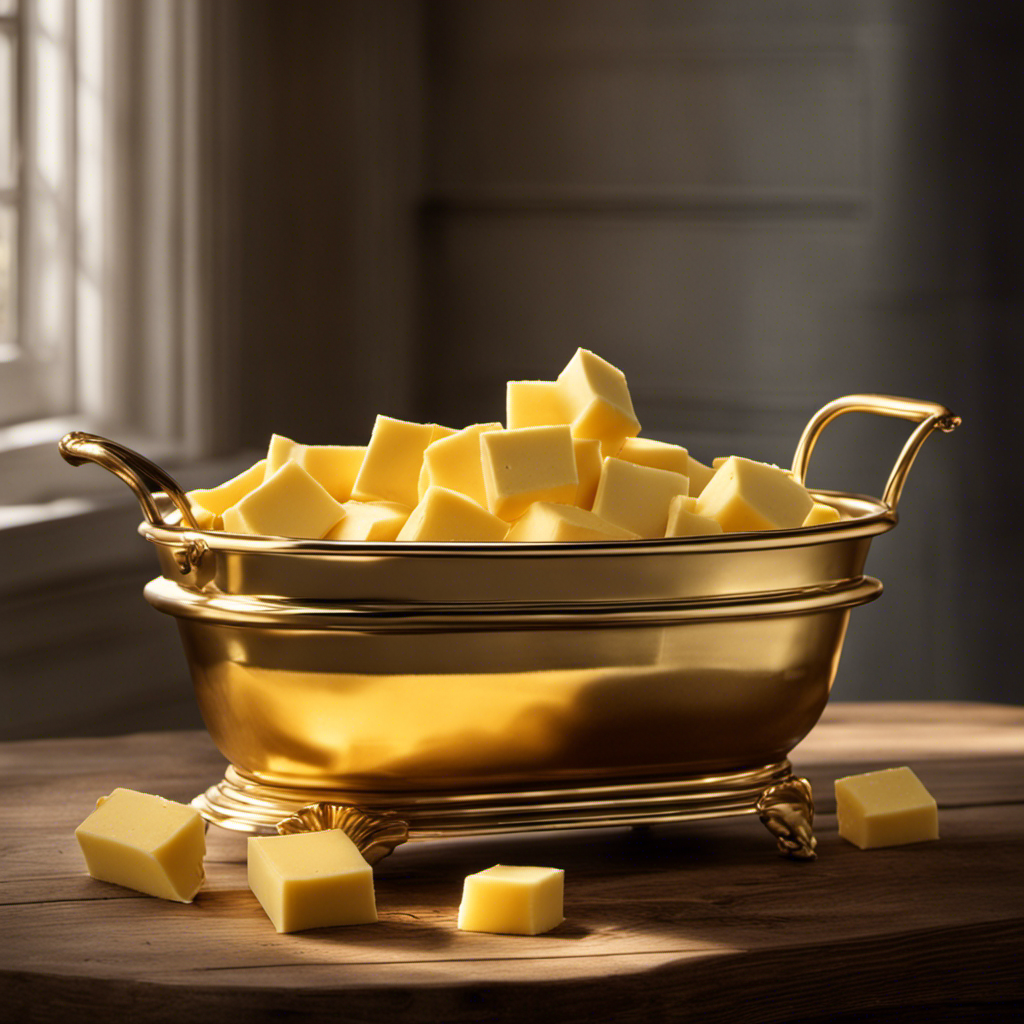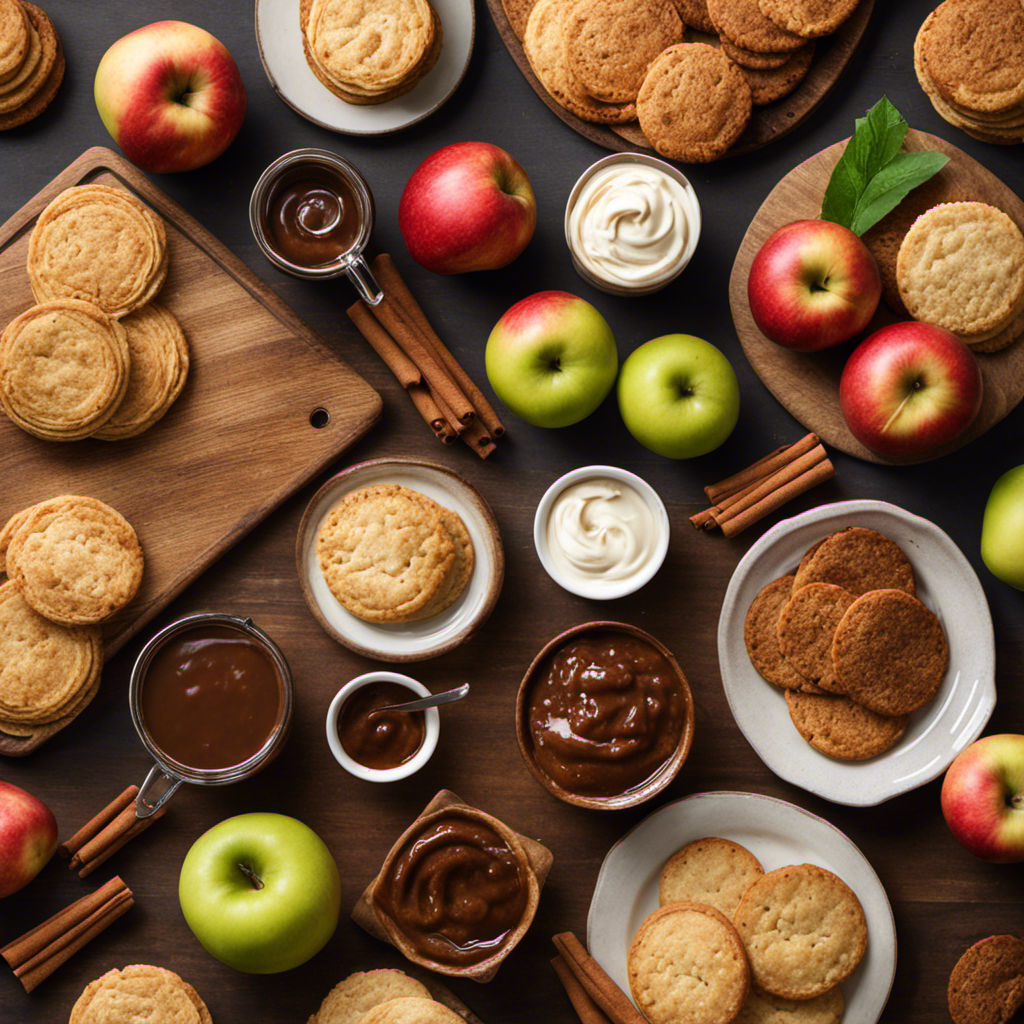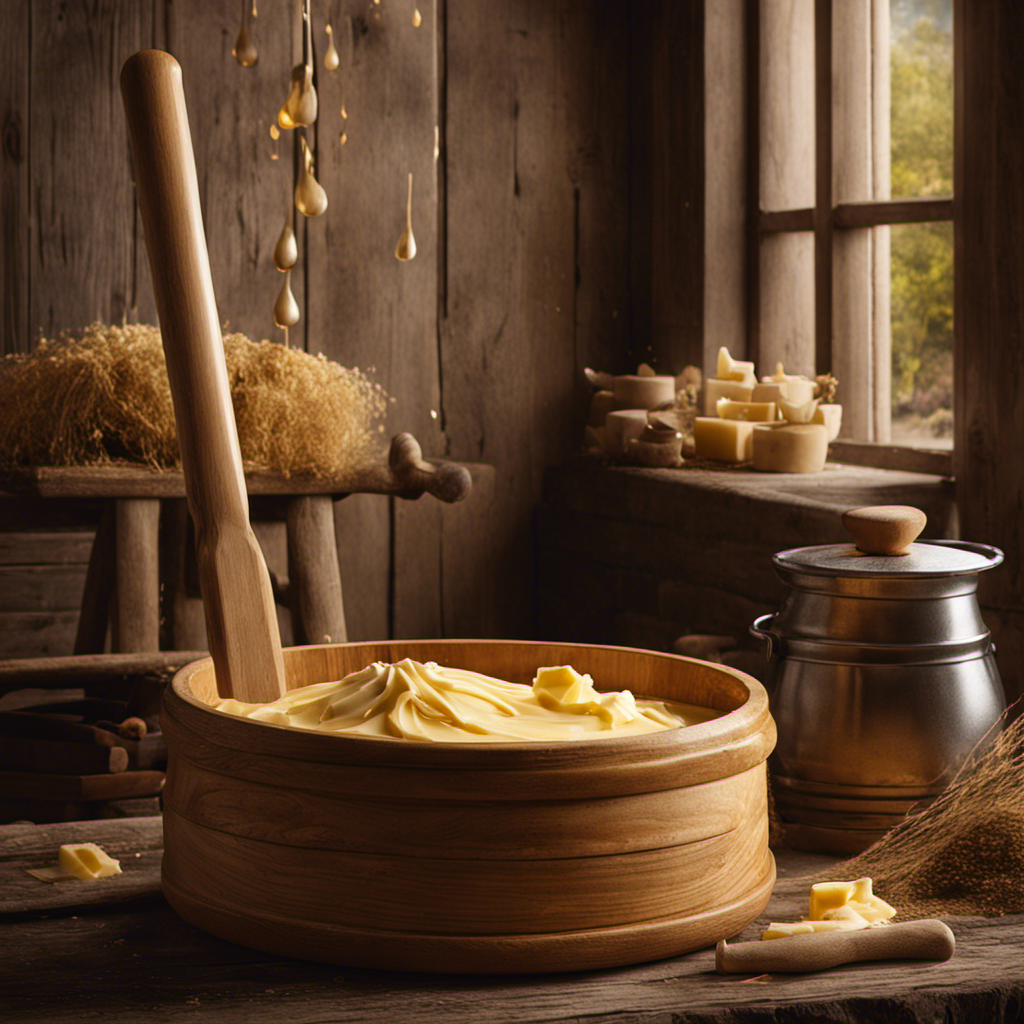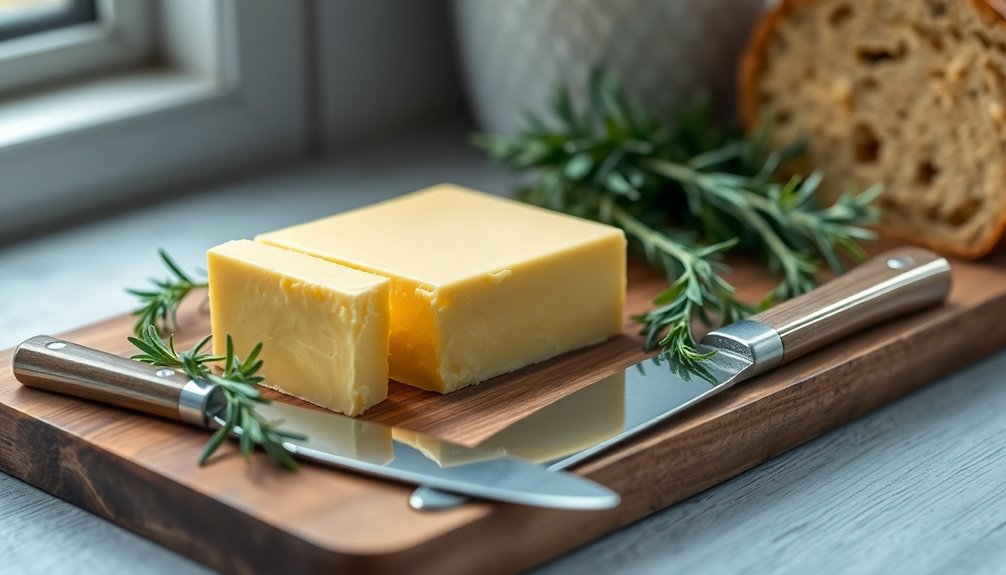Have you ever tried butter that is so rich and smooth that it melts on your tongue like magic? Let me introduce you to a butter that embodies that experience perfectly – Irish butter.
In this article, we will delve into the origins of Irish butter, explore the difference between Irish butter and regular butter, and uncover the unique tradition and quality standards that make Irish butter so highly sought after.
So, grab a slice of bread and get ready to discover the delicious world of Irish butter.
Key Takeaways
- Irish butter is made using traditional methods, which enhances its flavor and quality.
- Irish butter has a higher butterfat content, giving it a rich and creamy texture.
- Irish butter is known for its distinct flavor and sweetness, which comes from the cows grazing on nutrient-rich grass.
- Irish butter contains healthy fats, higher levels of omega-3 fatty acids, and vitamins, making it a nutritious option.
The Origins of Irish Butter
Irish butter is known for its rich and creamy texture.
The history of Irish butter making can be traced back centuries, and it holds a significant place in Irish culture.
The lush green landscapes and mild climate of Ireland provide ideal conditions for dairy farming, resulting in high-quality milk.
This milk is then churned into butter using traditional methods that have been passed down through generations.
The process involves separating the cream from the milk, allowing it to ferment slightly, and then churning it until it forms butter.
The cultural significance of Irish butter is evident in the way it is used in traditional Irish dishes, such as Irish soda bread and colcannon.
The creamy and indulgent taste of Irish butter adds a distinct richness to these recipes, making them truly authentic and delicious.
The Difference Between Irish Butter and Regular Butter
There’s a noticeable distinction between regular butter and the one from Ireland. Having tasted both, I can confidently say that Irish butter has a unique flavor and texture that sets it apart. But it’s not just about the taste, there are also nutritional differences that make Irish butter a healthier choice. Here are four key points to consider:
-
Higher butterfat content: Irish butter typically has a higher butterfat content, which gives it a rich and creamy texture. This also means that it contains more healthy fats.
-
Natural grazing: Irish cows are known for their access to lush green pastures, resulting in milk that is higher in nutrients like omega-3 fatty acids and vitamin K2.
-
No added hormones: Irish butter is often free of added hormones, making it a more natural and wholesome option.
-
Traditional production methods: Irish butter is often made using traditional methods, which can contribute to its superior flavor and quality.
The Creamery Tradition in Ireland
If you ever visit Ireland, you’ll be fascinated by the rich history and cultural significance of the creamery tradition. The creamery tradition in Ireland dates back centuries and is deeply rooted in the country’s agricultural heritage. It involves the production of high-quality dairy products, particularly butter, made from the milk of grass-fed cows. The creamery tradition has been passed down through generations, with families and communities coming together to churn butter and create delicious dairy treats. The process involves collecting fresh, rich milk from cows that graze on lush green pastures. This ensures that the butter produced is of the highest quality, with a distinct creamy texture and a rich, buttery flavor. The creamery tradition is not just about making butter; it represents a way of life and a connection to the land that is deeply cherished by the Irish people.
| Grass-Fed Cows | Creamery Tradition |
|---|---|
| Provide high-quality milk | Rich history and cultural significance |
| Grazing on lush green pastures | Passed down through generations |
| Distinct creamy texture and rich flavor | Connection to the land |
The Role of Grass-Fed Cows in Irish Butter Production
When you visit Ireland, you’ll notice how grass-fed cows play a crucial role in the production of creamy, high-quality dairy products. Irish farmers have a deep understanding of the benefits of grass-fed farming, and they prioritize sustainable practices to ensure the well-being of their cows and the environment.
Here are four reasons why grass-fed cows are essential for Irish butter production:
-
Superior taste: The natural diet of grass gives the milk a rich, flavorful taste that sets Irish butter apart.
-
Nutritional value: Grass-fed cows produce milk with higher levels of beneficial omega-3 fatty acids and vitamins.
-
Environmental sustainability: Grazing cows on lush pastures reduces the need for artificial feed, minimizing the carbon footprint of Irish butter production.
-
Animal welfare: Grass-fed cows enjoy a more natural and fulfilling life, with ample space to roam and graze.
The Taste Profile of Irish Butter
Grazing on lush pastures gives grass-fed cows in Ireland’s dairy industry a distinct taste profile in their creamy products. When it comes to Irish butter, the taste is truly remarkable. It is known for its richness and creaminess, which sets it apart from other butters on the market.
The flavor of Irish butter is bold and robust, with a hint of sweetness. It has a smooth and velvety texture that melts effortlessly in your mouth. Whether spread on warm toast or used in baking, Irish butter adds a deliciously decadent touch to any dish.
Its superior taste is a result of the cows’ diet, as they consume nutrient-rich grass all year round. So, next time you’re looking for butter that is full-bodied and indulgent, reach for Irish butter and savor the incredible taste.
The Health Benefits of Irish Butter
Grazing on nutrient-rich grass contributes to the health benefits of Irish butter, making it a wholesome choice. Here are four reasons why Irish butter is not only delicious but also good for you:
-
High in vitamins: Irish butter is rich in fat-soluble vitamins A, D, E, and K, which are essential for maintaining healthy skin, eyes, and immune system.
-
Omega-3 fatty acids: Due to the diet of grass-fed cows, Irish butter contains higher levels of omega-3 fatty acids, which are known for their heart-healthy benefits.
-
Antioxidants: Grass-fed cows produce milk with higher levels of antioxidants, including beta-carotene and vitamin E, which help protect the body against free radicals.
-
Lower in saturated fat: Compared to conventional butter, Irish butter has a lower level of saturated fat, making it a healthier choice for those watching their fat intake.
With its numerous health benefits and nutritional value, Irish butter is truly a superior choice. Now, let’s delve into the art of churning Irish butter.
The Art of Churning Irish Butter
To master the art of churning, you’ll need a few key ingredients and a bit of patience. Churning butter has a rich history, with traditional techniques passed down through generations.
The process begins with the freshest cream, preferably from grass-fed cows, as it contributes to the rich and creamy flavor of Irish butter. With a dash of sea salt and a wooden churn, the magic begins.
The cream is agitated vigorously, causing the fat globules to separate from the buttermilk. This process can take anywhere from 10 to 30 minutes, depending on the temperature and consistency of the cream.
Once the fat has solidified, it is shaped into a block or rolled into a log for easy storage. The result is a deliciously creamy and golden butter, perfect for spreading on warm bread or enhancing the flavor of your favorite dishes.
The Quality Standards for Irish Butter
When it comes to quality standards, you’ll find that Irish butter is held to high expectations. The meticulous attention to detail and stringent quality control measures ensure that every batch of Irish butter meets the highest standards.
Here are four reasons why Irish butter stands out in terms of quality:
-
Grass-fed cows: Irish butter is made from milk sourced from cows that graze on lush, green pastures, resulting in a rich and creamy flavor.
-
Traditional production methods: The age-old churning process used in Ireland allows for the development of a unique texture and taste that cannot be replicated.
-
Pure ingredients: Irish butter is made with just two ingredients – cream and salt – ensuring a pure and natural product.
-
Small-batch production: The production of Irish butter is often done on a smaller scale, allowing for greater attention to detail and quality control.
With such high-quality standards in place, it’s no wonder that Irish butter has gained a global reputation for excellence.
The Global Demand for Irish Butter
If you’re looking for a creamy and flavorful option, you’ll be pleased to know that the global demand for Irish butter is on the rise. Irish butter has gained popularity in recent years due to its superior quality and rich taste. Consumers around the world are increasingly opting for Irish butter over other varieties. This growing demand can be attributed to several factors, including the global market’s increased focus on high-quality dairy products and consumers’ changing preferences for natural and wholesome ingredients. Irish butter stands out for its distinct yellow color, smooth texture, and indulgent flavor. To better understand the global market for Irish butter, let’s take a look at the following table that highlights its key consumer preferences:
| Consumer Preferences | Percentage |
|---|---|
| Creaminess | 85% |
| Flavor | 92% |
| Natural Ingredients | 78% |
| Richness | 87% |
| Quality | 95% |
As you can see, the majority of consumers prioritize creaminess, flavor, natural ingredients, richness, and overall quality when choosing Irish butter. This aligns with the growing trend of seeking premium products that offer a superior taste and experience. Irish butter truly delivers on all these aspects, making it a top choice in the global market.
The Culinary Uses of Irish Butter
When it comes to culinary delights, Irish butter is a true gem. Its rich flavor profiles add a depth and creaminess to any dish, whether it’s a simple piece of toast or a complex sauce.
Not only is it versatile in recipes, easily melding with both sweet and savory ingredients, but it also shines in baked goods, providing a luscious texture and a buttery aroma that is simply irresistible.
Rich Flavor Profiles
The rich flavor profiles of Irish butter make it a favorite among chefs and food enthusiasts alike. Its unique taste and creamy texture elevate any dish to a whole new level. Here are four ways Irish butter enhances flavor pairing and cooking techniques:
-
Baking: When used in pastries and cakes, Irish butter adds a luxurious richness that enhances the overall flavor and texture of the baked goods.
-
Sautéing: The high butterfat content in Irish butter allows it to withstand high heat without burning, making it perfect for sautéing vegetables or searing meats.
-
Finishing touch: Adding a pat of Irish butter to a hot dish just before serving creates a velvety smooth finish and intensifies the flavors.
-
Spreading: Whether on warm bread or toasted bagels, Irish butter spreads like a dream, releasing its rich, creamy taste with every bite.
Incorporating Irish butter into your cooking repertoire will undoubtedly elevate your flavor game and leave your taste buds craving for more.
Versatile in Recipes
Incorporating this versatile ingredient into various recipes will undoubtedly elevate the flavor profile and leave your taste buds craving for more. Irish butter is not only known for its rich flavor profiles but also for its ability to enhance the taste of any dish. Whether you’re baking a batch of warm chocolate chip cookies or sautéing vegetables for a delicious stir-fry, Irish butter adds a creamy and indulgent touch that takes your culinary creations to a whole new level. Its smooth and velvety texture melts beautifully, coating every ingredient with a rich and buttery goodness. From breakfast classics like fluffy pancakes to savory dishes like garlic butter shrimp, this versatile ingredient is a must-have in your kitchen. Check out the table below to explore some popular recipes where Irish butter truly shines.
| Recipe | Description | Flavor Enhancement |
|---|---|---|
| Irish Soda Bread | Traditional Irish bread with a buttery taste | Rich and creamy |
| Lobster Mac n’ Cheese | Creamy pasta dish with succulent lobster chunks | Decadent and indulgent |
| Lemon Butter Salmon | Grilled salmon topped with tangy lemon butter sauce | Zesty and flavorful |
No matter what recipe you choose, incorporating Irish butter into your cooking will undoubtedly enhance the flavors and leave your taste buds wanting more. So go ahead, experiment with this versatile ingredient and discover a whole new world of culinary delights.
Enhances Baked Goods
Baking with Irish butter can add a rich and indulgent flavor to your favorite treats. Not only does it enhance the taste, but it also improves the texture of your baked goods. Here are four reasons why using Irish butter can take your baking to the next level:
-
Creaminess: Irish butter has a higher butterfat content, which gives it a creamy and smooth texture. This translates to a velvety mouthfeel in your baked goods.
-
Richness: The high butterfat content in Irish butter adds a luxurious richness to your treats, making them taste more decadent and indulgent.
-
Depth of Flavor: Irish butter has a distinct, savory taste that adds depth to your baked goods. It elevates the overall flavor profile, making each bite more satisfying.
-
Moisture: The higher butterfat content in Irish butter helps retain moisture in your baked goods, resulting in a softer and more tender texture.
The Future of Irish Butter Industry
When it comes to the future of the Irish butter industry, there are three key points that deserve attention: market expansion potential, sustainability, and innovation.
First, the market expansion potential for Irish butter is promising, with a growing demand both domestically and internationally.
Second, ensuring sustainability in the production of Irish butter is crucial to maintain its reputation for high quality and ethical practices.
Finally, embracing innovation in the industry will be essential to stay ahead of the competition and meet the evolving needs and preferences of consumers.
Together, these three factors will shape the future of the Irish butter industry and determine its success in the global market.
Market Expansion Potential
The market potential for Irish butter is enormous, with consumers increasingly seeking out its rich and creamy taste. As a lover of Irish butter myself, I can understand why it has become such a popular choice. Here are four reasons why Irish butter has such great market opportunities and is preferred by consumers:
-
Grass-fed cows: Irish butter is made from the milk of cows that graze on lush, green pastures. This natural diet gives the butter a distinct flavor and a higher content of beneficial nutrients.
-
Traditional production methods: Irish butter is still made using traditional churns, which slow the process and allow for the development of a rich, creamy texture. This attention to detail and craftsmanship is appreciated by discerning consumers.
-
Pure and natural: Irish butter is free from artificial additives and preservatives, making it a healthier choice for those who prioritize natural ingredients.
-
Versatile and delicious: Irish butter is not only great for spreading on toast or scones; it also enhances the flavor of baked goods and adds richness to sauces and dishes.
With these market opportunities and consumer preferences, the future of Irish butter looks incredibly bright.
Sustainability and Innovation
If you want to make a positive impact on the environment, you should consider supporting sustainable and innovative practices in the food industry. Sustainability practices and innovative production techniques are crucial in ensuring a greener and healthier future for our planet.
In the food industry, these practices involve minimizing waste, reducing carbon emissions, and promoting ethical sourcing of ingredients. Companies are adopting innovative techniques such as vertical farming, hydroponics, and aquaponics to produce food in a more sustainable way. They are also exploring alternative energy sources and implementing recycling programs to reduce their ecological footprint.
Frequently Asked Questions
How Long Does It Take to Churn Irish Butter?
Churning Irish butter is a time-consuming process that requires patience. Traditional methods involve separating cream from milk, then agitating it until it transforms into butter. The length of time can vary, but it usually takes several minutes of consistent churning.
Can Irish Butter Be Used as a Substitute for Regular Butter in Baking?
Irish butter can absolutely be used as a substitute for regular butter in baking. It has a rich, creamy texture and a higher fat content, which enhances the flavor and moisture of baked goods. The main difference between Irish butter and regular butter lies in the cows’ diet and the production process, resulting in a distinct taste and superior quality. Give it a try and experience the benefits of indulging in this delicious golden treasure.
Are There Any Specific Recipes That Highlight the Taste of Irish Butter?
Specific recipe suggestions that highlight the rich taste of Irish butter include traditional Irish soda bread, flaky scones, and creamy mashed potatoes. Besides its delightful flavor, Irish butter is also known for its higher fat content and natural, grass-fed goodness.
What Makes Grass-Fed Cows in Ireland Produce Higher Quality Butter?
Grass-fed cows in Ireland produce higher quality butter due to their diet rich in green grass. The natural flavors and nutrients from the grass are passed on to the milk, resulting in a butter that is more flavorful and nutritious.
Is Irish Butter More Expensive Than Regular Butter?
Irish butter, known for its rich flavor, is often priced higher than regular butter due to its higher fat content. However, the health benefits of Irish butter, such as being a good source of vitamins A and E, make it worth the investment.
Conclusion
In conclusion, Irish butter is a rich and flavorful dairy product that has a long-standing tradition in Ireland. Its unique taste and creamy texture can be attributed to the creamery tradition and the practice of using grass-fed cows.
It is interesting to note that the global demand for Irish butter has been steadily increasing, with exports reaching over 200,000 tons in recent years. This statistic highlights the widespread love and appreciation for the deliciousness of Irish butter, and it’s no wonder why it is highly sought after worldwide.
So, whether you’re spreading it on toast or using it in your favorite recipes, Irish butter is sure to add a touch of indulgence to any dish.










